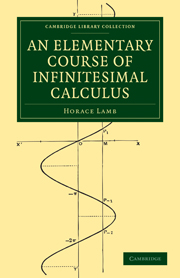Book contents
- Frontmatter
- PREFACE
- Contents
- CHAPTER I CONTINUITY
- CHAPTER II DERIVED FUNCTIONS
- CHAPTER III THE EXPONENTIAL AND LOGARITHMIC FUNCTIONS
- CHAPTER IV APPLICATIONS OF THE DERIVED FUNCTION
- CHAPTER V DERIVATIVES OF HIGHER ORDERS
- CHAPTER VI INTEGRATION
- CHAPTER VII DEFINITE INTEGRALS
- CHAPTER VIII GEOMETRICAL APPLICATIONS
- CHAPTER IX SPECIAL CURVES
- CHAPTER X CURVATURE
- CHAPTER XI DIFFERENTIAL EQUATIONS OF THE FIRST ORDER
- CHAPTER XII DIFFERENTIAL EQUATIONS OF THE SECOND ORDER
- CHAPTER XIII LINEAR EQUATIONS WITH CONSTANT COEFFICIENTS
- CHAPTER XIV DIFFERENTIATION AND INTEGRATION OF POWER-SERIES
- CHAPTER XV TAYLOR'S THEOREM
- CHAPTER XVI FUNCTIONS OF SEVERAL INDEPENDENT VARIABLES
- APPENDIX: NUMERICAL TABLES
- INDEX
CHAPTER I - CONTINUITY
Published online by Cambridge University Press: 07 September 2010
- Frontmatter
- PREFACE
- Contents
- CHAPTER I CONTINUITY
- CHAPTER II DERIVED FUNCTIONS
- CHAPTER III THE EXPONENTIAL AND LOGARITHMIC FUNCTIONS
- CHAPTER IV APPLICATIONS OF THE DERIVED FUNCTION
- CHAPTER V DERIVATIVES OF HIGHER ORDERS
- CHAPTER VI INTEGRATION
- CHAPTER VII DEFINITE INTEGRALS
- CHAPTER VIII GEOMETRICAL APPLICATIONS
- CHAPTER IX SPECIAL CURVES
- CHAPTER X CURVATURE
- CHAPTER XI DIFFERENTIAL EQUATIONS OF THE FIRST ORDER
- CHAPTER XII DIFFERENTIAL EQUATIONS OF THE SECOND ORDER
- CHAPTER XIII LINEAR EQUATIONS WITH CONSTANT COEFFICIENTS
- CHAPTER XIV DIFFERENTIATION AND INTEGRATION OF POWER-SERIES
- CHAPTER XV TAYLOR'S THEOREM
- CHAPTER XVI FUNCTIONS OF SEVERAL INDEPENDENT VARIABLES
- APPENDIX: NUMERICAL TABLES
- INDEX
Summary
Continuous Variation
In every problem of the Infinitesimal Calculus we have to deal with a number of magnitudes, or quantities, some of which may be constant, whilst others are regarded as variable, and (moreover) as admitting of continuous variation.
Thus in the applications to Geometry, the magnitudes in question may be lengths, angles, areas, volumes, &c; in Dynamics they may be masses, times, velocities, forces, &c.
Algebraically, any such magnitude is represented by a letter, such as a or x, denoting the ratio which it bears to some standard or ‘unit’ magnitude of its own kind. This ratio may be integral, or fractional, or it may be ‘incommensurable,’ i.e. it may not admit of being exactly represented by any fraction whose numerator and denominator are finite integers. Its symbol will in any case be subject to the ordinary rules of Algebra.
A ‘constant’ magnitude, in any given process, is one which does not change its value. A magnitude to which, in the course of any given process, different values are assigned, is said to be ‘variable.’ The earlier letters a, b, c, … of the alphabet are generally used to denote constant, and the later letters …u, v, w, x, y, z to denote variable magnitudes.
Some kinds of magnitude, as for instance lengths, masses, densities, do not admit of variety of sign. Others, such as altitudes, rotations, velocities, may be either positive or negative.
- Type
- Chapter
- Information
- An Elementary Course of Infinitesimal Calculus , pp. 1 - 44Publisher: Cambridge University PressPrint publication year: 2009First published in: 1897

